How to Grow Mugwort: Cultivating Your Herbal Garden Ally
- March 4, 2024
- 0 comment
Mugwort (Artemisia vulgaris), a perennial plant with a rich history in herbal medicine and culinary traditions, is a fascinating addition to any garden. Its unique aroma and distinctive foliage make it a popular choice for both ornamental and practical purposes. In this article, we’ll guide you through the steps of growing mugwort, from planting to harvesting.

Mugwort Benefits
| Benefit | Description |
|---|---|
| Digestive Aid | Mugwort has been traditionally used to stimulate and aid digestion, helping to alleviate issues like bloating, gas, and constipation. |
| Menstrual Relief | It’s known for its emmenagogue properties, meaning it can stimulate blood flow in the pelvic area and uterus, thereby helping to regulate menstruation and ease menstrual cramps. |
| Sedative Properties | Mugwort is believed to have mild sedative effects and has been used to help alleviate insomnia and anxiety, promoting relaxation and better sleep. |
| Antimicrobial | The herb has antimicrobial properties, making it useful in fighting off bacterial and fungal infections. |
| Moxibustion Therapy | In traditional Chinese medicine, mugwort is dried and burned in a process called moxibustion. This is used to promote healing by stimulating the flow of Qi (energy). |
| Dream Enhancement | Mugwort is often associated with enhancing dream recall and vividness, making it a popular choice for those interested in lucid dreaming. |
| Culinary Uses | It adds a unique flavor to various dishes, especially in Eastern cuisine, and is also used in the brewing of some types of beer. |
| Anti-Inflammatory | Mugwort contains compounds that have anti-inflammatory properties, making it beneficial in reducing inflammation in various conditions. |
| Liver Health | There is some evidence suggesting that mugwort can support liver health and help in detoxifying the body. |
| Antioxidant Properties | The plant is rich in antioxidants, which help in protecting the body from oxidative stress and free radical damage. |
Choosing a Planting Site
Mugwort prefers a sunny location but can also tolerate partial shade. It’s not particularly fussy about soil type, although well-drained soil is ideal. Be mindful of its invasive nature; mugwort can spread rapidly through its root system. Consider planting it in a contained area or using root barriers to prevent it from overtaking your garden.

Sunlight and Shade
- Sunlight: Mugwort thrives best in full sun. A location that receives at least 6 hours of direct sunlight daily is ideal. This promotes robust growth, healthier plants, and more aromatic leaves.
- Partial Shade: While it prefers full sun, mugwort can also do well in partial shade. This adaptability makes it suitable for different areas of the garden, but remember that less sun might result in less vigorous growth.
Soil Conditions
- Soil Type: Mugwort is not overly demanding regarding soil quality. It can grow in a variety of soil types, including loamy, sandy, and even clay soils.
- Drainage: Good drainage is essential. Mugwort doesn’t like to sit in waterlogged soil, which can lead to root rot. If your garden has heavy or compact soil, consider amending it with organic matter to improve drainage.
- pH Preference: Mugwort is adaptable to a range of soil pH levels, but it generally prefers slightly acidic to neutral soil.
Managing Invasiveness
- Rapid Spread: One of the critical aspects of growing mugwort is managing its tendency to spread aggressively. It can quickly take over garden spaces due to its robust root system.
- Containment Strategies:
- Physical Barriers: Planting mugwort in a contained area, such as a raised bed with solid edges, can help prevent the roots from spreading.
- Root Barriers: Installing root barriers in the soil around the planting area can also be an effective way to control its spread. These barriers should be buried deep enough to prevent the roots from growing underneath.
- Container Planting: Growing mugwort in large containers is another excellent way to enjoy the plant without worrying about it taking over. Ensure the container has ample space and good drainage.
Planting Mugwort
Planting Mugwort from Seeds
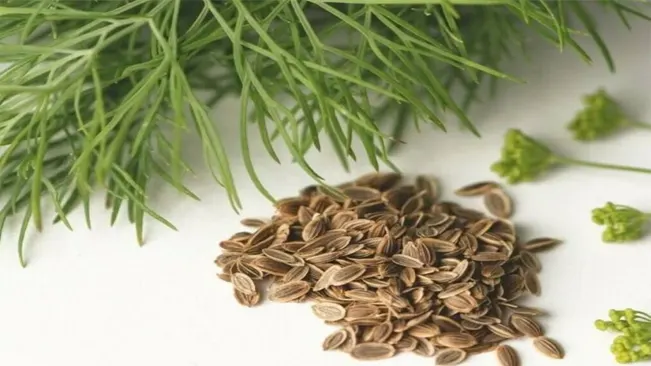
- Selecting Seeds: Choose high-quality mugwort seeds from a reputable source. This ensures better germination rates and plant health.
- Timing: The best time to start sowing mugwort seeds indoors is about 6-8 weeks before the last expected frost date in your area. This gives the plants enough time to grow strong enough to withstand outdoor conditions.
- Seed Starting Mix: Use a lightweight, well-draining seed starting mix. This type of soil ensures proper aeration and moisture retention, crucial for seed germination.
- Sowing the Seeds: Spread the seeds thinly over the surface of the soil. Mugwort seeds need light to germinate, so do not cover them with soil. Instead, press them gently into the soil with your hand or a flat object.
- Light and Temperature: Place the seed trays in a warm area with plenty of indirect light. The ideal germination temperature for mugwort is around 18-22°C (65-72°F).
- Watering: Keep the soil consistently moist but not waterlogged. Using a spray bottle to mist the soil can prevent overwatering.
- Transplanting Seedlings: Once the seedlings have grown strong and the risk of frost has passed, they can be transplanted outdoors. Harden off the seedlings by gradually exposing them to outdoor conditions over a week to reduce transplant shock.
Planting Mugwort from Root Cuttings

- Choosing the Right Time: The best times for taking root cuttings are either early spring or fall. This is when the plant is not actively growing, and the energy is concentrated in the roots.
- Preparing Cuttings: Choose healthy, established mugwort plants to take cuttings from. Cuttings should be about 10-15 cm long. Use a clean, sharp knife or pruning shears to make the cuts.
- Planting Cuttings: Dig small holes in your prepared garden bed or container and place the cuttings in them. Ensure that the top of each cutting is just above the soil surface. Backfill the soil and press it down gently around the cutting.
- Watering and Care: Water the newly planted cuttings well. In the initial stages, keep the soil moist to encourage root development. Once the cuttings have established, reduce watering as mugwort is drought-tolerant.
- Spacing: If planting multiple cuttings, space them about 30-40 cm apart to allow for growth and air circulation.
Caring for Mugwort
Watering
Although mugwort is known for its drought tolerance, proper watering is crucial, especially in the early stages of growth. Here are some tips:
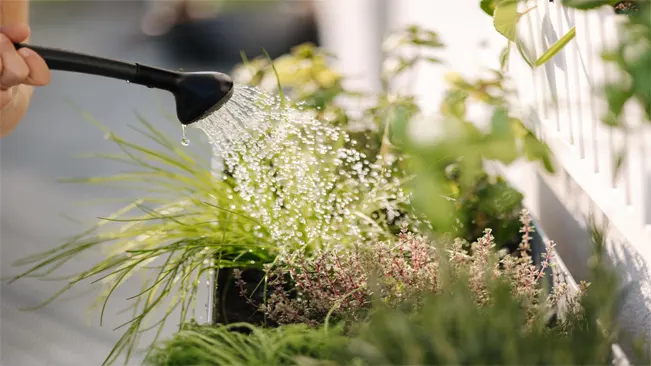
- Initial Growth: During the first growing season, ensure mugwort receives consistent moisture. This helps establish a robust root system.
- Mature Plants: Once established, mugwort requires less water. However, during extended dry periods, it’s beneficial to water the plants to maintain health and vigor.
- Watering Technique: When watering, aim for the base of the plant to avoid wetting the foliage, as this can reduce the risk of fungal diseases.
- Monitoring: The best way to determine if mugwort needs water is to check the soil moisture. Water the plant when the top inch of soil feels dry.
Weeding
Weeding is important in the care of mugwort for several reasons:
- Nutrient Competition: Weeds compete with mugwort for nutrients and water, which can affect the plant’s growth.
- Air Circulation: Removing weeds around mugwort improves air circulation, reducing the likelihood of disease.
- Regular Maintenance: Regularly check for and remove weeds. This not only benefits the mugwort but also maintains the overall health and appearance of your garden.
Mulching
Mulching provides multiple benefits for mugwort:
- Moisture Retention: A layer of organic mulch helps retain soil moisture, reducing the need for frequent watering.
- Weed Suppression: Mulch acts as a barrier to weed growth, minimizing the need for regular weeding.
- Soil Temperature Regulation: Mulch helps regulate soil temperature, keeping roots cooler in summer and warmer in winter.
- Organic Matter: As organic mulch decomposes, it adds beneficial nutrients to the soil, enhancing its quality.
Pruning
Pruning is an essential part of mugwort care:
- Growth Control: Pruning helps control the size and spread of mugwort. Since it can be invasive, pruning prevents it from overtaking other plants in the garden.
- Prevent Seeding: By pruning mugwort after flowering, you can prevent the plant from seeding and spreading uncontrollably.
- Encourage New Growth: Pruning in early spring encourages new, healthy growth. It can also help in shaping the plant and maintaining an aesthetically pleasing appearance.
- Method: Use clean, sharp pruning shears. Cut back the stems to a desired height, keeping in mind the overall shape you want for your plant.
Harvesting and Uses
Harvesting Mugwort
Mugwort can be harvested several times during the growing season, but the best time for harvesting is just before the plant flowers. This is typically in late spring or early summer, depending on your climate. During this period, the leaves are at their most aromatic and potent.
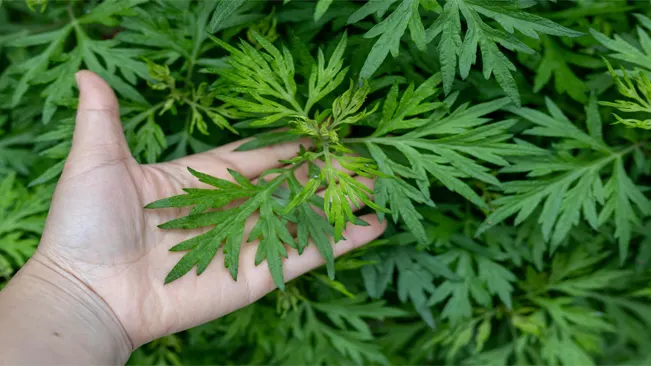
How to Harvest:
- Timing: Choose a dry day to harvest mugwort. Early morning after the dew has evaporated is ideal.
- Method: Use sharp scissors or pruning shears to cut the top one-third of the branches. This part of the plant has the most concentrated aroma and flavor.
- Post-Harvest: After harvesting, shake off any dirt or insects and rinse the leaves if necessary. Then, you can either use them fresh or dry them for later use.
Drying Mugwort
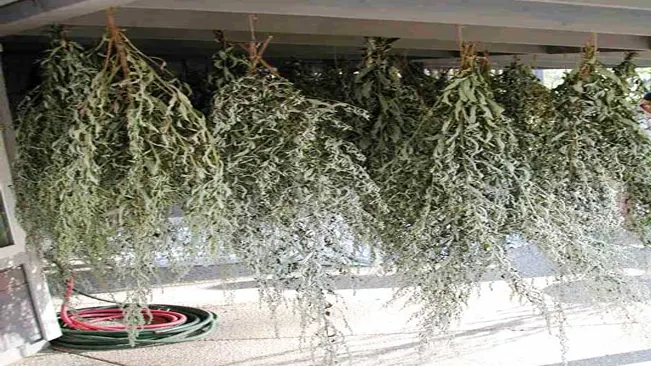
- To dry mugwort, hang the harvested branches upside down in a dry, well-ventilated area away from direct sunlight. Once the leaves are completely dry, strip them from the stems and store them in an airtight container away from light and moisture.
Uses of Mugwort
Mugwort’s uses are diverse, ranging from culinary to medicinal:
- Culinary Uses: Mugwort has a bitter, slightly minty flavor. It can be used to flavor meats, fish, and various traditional dishes, especially in Asian cuisine. In Japan, it’s used in making mochi, a type of rice cake. It’s also been historically used in Europe to flavor beer before the widespread use of hops.
- Tea: Mugwort tea is popular for its potential health benefits. To make the tea, steep dried or fresh mugwort leaves in hot water. It’s said to aid digestion, promote relaxation, and help with menstrual cramps.
- Herbal Remedies: Traditionally, mugwort has been used in various forms (such as poultices or infusions) for its medicinal properties. It’s believed to have anti-inflammatory, diuretic, and antimicrobial effects.
- Aromatherapy and Incense: The leaves can be used in aromatherapy or burned as incense for their calming fragrance. This practice is common in various spiritual and cleansing rituals.
- Dream Work: Some people keep dried mugwort under their pillow or use it in dream pillows to enhance dream recall and vividness.
Potential Pests and Problems
Mugwort is relatively pest-resistant. However, watch out for common garden pests like aphids and spider mites. Regular inspection and maintaining healthy growing conditions are usually sufficient to keep pests at bay.
Aphids
- Identification: Small, soft-bodied insects that can be green, yellow, brown, red, or black. They typically cluster on the undersides of leaves and along stems.
- Damage: Aphids suck sap from the plant, which can lead to distorted growth and yellowing leaves. They also excrete a sticky substance known as honeydew, which can encourage the growth of sooty mold.
- Control: Natural predators like ladybugs and lacewings can help. You can also wash them off with a strong jet of water or use insecticidal soap.
Spider Mites
- Identification: Very tiny spider-like pests that are often red, green, or yellow. They are usually found on the undersides of leaves.
- Damage: They feed by piercing leaf tissue and sucking out the contents, causing yellow or bronze speckling on leaves. Severe infestations can lead to leaf drop.
- Control: Increase humidity around the plant, as spider mites thrive in dry conditions. Use miticides or insecticidal soap if necessary.
Rust
- Identification: Mugwort can sometimes be affected by rust, a fungal disease. Look for orange or brown pustules on the undersides of leaves.
- Damage: Rust can cause leaves to become discolored and drop prematurely.
- Control: Prune affected areas and improve air circulation. Fungicides can be used in severe cases.
Powdery Mildew
- Identification: A white, powdery fungal growth on the surface of leaves.
- Damage: It can cause leaves to become stunted and distorted.
- Control: Improve air circulation and reduce humidity around the plant. Fungicides can be used if necessary.
Root Rot
- Identification: Occurs in overly wet or poorly drained soil. The plant may appear wilted or stunted, and the roots will be brown and mushy.
- Damage: Root rot can kill the plant if not addressed.
- Control: Ensure good drainage in the soil. Avoid overwatering.
General Care Tips to Prevent Pests and Problems
- Regular Inspection: Check your plants frequently for signs of pests or disease.
- Proper Watering: Water the plants adequately but avoid overwatering, as mugwort doesn’t like soggy soil.
- Good Air Circulation: Space plants properly and prune them as needed to ensure good air circulation.
- Weed Control: Keep the area around your mugwort plants weed-free to reduce competition and the likelihood of disease.
- Healthy Soil: Maintain nutrient-rich, well-draining soil to keep your plants healthy and more resistant to pests and diseases.
Conclusion
Growing mugwort can be a rewarding experience for gardeners interested in herbs and traditional medicine. With its easy-to-grow nature and versatile uses, it’s a worthy addition to any garden. Remember to manage its growth carefully to prevent it from becoming invasive. Happy gardening!
FAQs (Frequently Asked Questions)
- What is the best time to plant mugwort?
Mugwort seeds or cuttings are best planted in spring, after the last frost, to give the plant a full growing season. - Does mugwort need full sun or shade?
Mugwort thrives in full sun but can also tolerate partial shade. However, full sun encourages better growth and foliage production. - How much space does a mugwort plant need?
Space mugwort plants about 30-40 cm apart. They can grow quite large and spread out, so adequate spacing is crucial. - What type of soil is ideal for growing mugwort?
Mugwort isn’t very picky about soil but prefers well-drained soil. It can tolerate a wide range of soil types, including poor soils. - How often should I water mugwort?
Water newly planted mugwort regularly to establish roots. Once established, it’s drought-tolerant and needs only occasional watering. - Does mugwort require fertilization?
Mugwort generally doesn’t require frequent fertilization. An annual application of compost or general-purpose fertilizer can be sufficient. - How do I prevent mugwort from spreading uncontrollably?
To control its spread, consider planting mugwort in containers or using root barriers. Regular pruning and removing the flower heads before they set seeds can also help. - When and how should I harvest mugwort?
Harvest mugwort leaves before the plant flowers, typically in late spring or early summer. Cut the top one-third of the branches when the leaves are the most aromatic. - Are there any common pests or diseases that affect mugwort?
Mugwort is relatively pest-resistant, but it can occasionally attract aphids or spider mites. Regular inspection and maintaining healthy plants are usually enough to prevent serious problems. - Can mugwort be grown in containers?
Yes, mugwort can be grown in containers, which also helps to control its invasive nature. Ensure the container is large enough and has good drainage.

Kristine Moore
Forestry AuthorI'm Kristine Moore, a seasoned garden landscaping professional with over 30 years of experience. My extensive career has been dedicated to transforming outdoor spaces into stunning, sustainable landscapes. With a deep understanding of horticulture, design principles, and environmental stewardship, I have become a respected figure in the field, known for creating harmonious, visually appealing, and eco-friendly gardens. My commitment to excellence and continuous learning in landscaping trends and techniques has solidified my reputation as an expert in garden design and implementation.

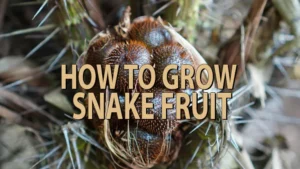











Leave your comment